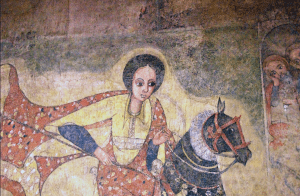Ethiopia
14th century CE
Kebra Nagast
Although the initial composition of the Kebra Nagast (KN) is still debated, the complete Ethiopic version is believed to have existed since the time of Emperor Amde Tsion, the fourteenth-century A.D. monarch of Ethiopia.
The KN is widely viewed as a national epic that historically motivated the Ethiopian monarchs in the spread of Christianity and the expansion of the country’s territory (Levine, 1974). In addition, until the fall of Emperor Haile Selassie I in 1974, the KN was considered a divinely-inspired document that helped to legitimize the Ethiopian monarchy itself. A very good indication of the importance of the KN to the Ethiopian rulers is found in a letter sent to Lord Granville, British Foreign Secretary, by Emperor Yohannis IV in 1872 (Hubbard, 1956). After the British defeated the Ethiopian soldiers in 1868, leading to the suicide of Emperor Tewodros II of Ethiopia, the British took two copies of the KN that they found at the royal palace to Britain. Once Emperor Yohannis, the succeeding monarch, learned about the missing copies of the KN, he wrote: ‘“There is a book called ‘Kivera Negust’ which contains the Law of the whole of Ethiopia, and the names of the Shums [i.e., Chiefs], and Churches, and Provinces are in this book. I pray you find out who has got this book, and send it to me, for in my country my people will not obey my orders without it”’ (Budge: 2004: xxvii). As a result, one of the two books was returned to Ethiopia in 1872. Moreover, the significance of the KN is expressed in Emperor Haile Selassie’s 1955 revised constitution. According to Chapter 1, Article II: “The Imperial dignity shall remain perpetually attached to the line of Haile Selassie I, descendant of King Sahle Selassie, whose line descends without interruption from the dynasty of Menelik I, son of the Queen of Ethiopia, the Queen of Sheba, and King Solomon of Jerusalem.”
Although many scholars have written about the KN, key questions about this document remain unanswered. For instance, scholars of both Ethiopian and Western origins disagree on its authorship, period of composition, and original purpose. The most popular explanation given by scholars has been that the book was written in the thirteenth or fourteenth century to legitimize the Solomonic dynasty of Ethiopia, which, after interrupted by the Zagwe Dynasty for about two hundred years, was restored in 1270 A. D. (Jones and Monroe, 1969). Others claim that it ought to be a sixth-century A.D. document written to glorify King Caleb, the sixth-century Christian monarch of Ethiopia (Shahid, 1976). The latter refer to the concluding chapter and the colophon found at the end of the KN as evidence. Although the colophon does not suggest that the KN was written in the sixth century, the story in the book ends with historical facts that have been verified (Shahid, 1976). For instance, the last chapter deals with the war between Caleb, the Christian king of Ethiopia, and Yusuf, the Jewish king of south Arabia. To Leeman (2005), the centrepiece of the KN (excluding the introduction and concluding chapters, which might have been added later on) may have been written before the complete Old Testament, Torah, was compiled. The fact that the centrepiece of the KN deals only with pre-Ezra Israelite religious practices like dietary prescriptions and the worship of the Ark suggests that the KN may have been written during and/or a few decades after the death of Solomon.
A further insight supporting Leeman’s pre-sixth-century A.D. thesis could be gleaned by comparing the Arabic and the Ethiopic KN texts. An Arabic KN text was, like the Ethiopic KN, translated into German by Carl Bezold in the early twentieth century. Whereas the Ethiopic KN ends with the story of King Caleb defeating King Yusuf of South Arabia in the sixth century A.D., the Arabic KN text does not go that far. In fact, the Arabic KN text gets only as far as the period in which Parmenas, one of the deacons at the See of St. Mark in Alexandria in the first century A.D., arrived in Abyssinia (former name of Ethiopia) and baptized the inhabitants. Since the Arabic KN text is much shorter than the Ethiopic KN (about 17 pages vs. about 211 pages, respectively), Bezold considers the former an excerpt of the latter (Hubbard, 1956). Tiruneh (2014, 2015) has, however, contended that the latter is perhaps an expanded version of the former. In other words, it is probably the Arabic text, with all of its references to older stories occurring before the sixth century A.D., that was written before the Ethiopic KN.
Moreover, while some thought that the Ethiopian scribe who translated the KN from Arabic to Ethiopic was the actual writer of the text (Levine, 1974), others have speculated that it could be someone of a Coptic or Semitic origin (Budge, 2004). It has been argued, for instance, that the KN might have been written by the Nine Saints, the name given to Monophysite monks who relocated from Syria and other Middle Eastern countries to Ethiopia in the fifth and sixth centuries (Lehman, 2005). At the Council of Chalcedon in 451 A. D., the controversy over the exclusively divine or mixed divine and human nature of Christ was resolved in favour of those who argued that He was both fully divine and fully human at the same time. The Monophysite monks, who believed in the inseparability of Christ’s divinity and humanity, were defeated and eventually persecuted for not agreeing with the new dogma. The monks subsequently moved to Axum, the ancient capital of Ethiopia, where they translated several religious books into Ethiopic, including the Old and New Testaments. They also helped the formation of monasteries and the spread of Christianity in the country (Hubbard, 1956). Given that King Caleb had treated them well and given them the resources they needed to spread Christian faith in his kingdom, the Nine Saints might have been motivated in writing the KN (or revising one that existed in oral or written form at the time) in order to glorify the Ethiopian kings as the guardians of the Judeo-Christian religion.
Gizachew Tiruneh
University of Central Arkansas
References
Budge, E. A. Wallis. (2004). The Kebra Nagast. New York: Cosimo Classics.
Hubbard, David. (1956). The Literary Sources of the Kebra Nagast. Ph. D. Thesis. Scotland: University of St. Andrews.
Jones, A.H.M. and Elizabeth Monroe. (1969). A History of Abyssinia. New York: Negro University Press.
Leeman, Bernard. (2005). Queen of Sheba and Biblical Scholarship. Australia: Academic Press.
Levine, Donald. (1974). Greater Ethiopia. Chicago: University of Chicago Press.
Shahid, Irfan. (1976). “The Kebra Nagast in the Light of Recent Research”, Le Museon 89: 133-178.
Tiruneh, Gizachew. (2014). “The Kebra Nagast: Can its Secrets be revealed? International Journal of Ethiopian Studies. Vol. III: 51-72.
Tiruneh, Gizachew. (2015). The Rise and Fall of the Solomonic Dynasty of Ethiopia: Is the Kebra Nagast a Time-Bound Document? Los Angeles: Tsehai Publishers.
Resources
Digitized Manuscript of the Kebra Nagast at the British Library
Post by Wendy Laura Belcher about her book project The Black Queen of Sheba: A Global History of an African Idea.
In the news:
Jeffrey, James. “Why the debate continues over repatriating looted Ethiopian treasures.” The World. May 24, 2018.
Wood, Michael. “The Queen of Sheba.” BBC. February 17, 2001.
Video of the last emperor of Ethiopia, Haile Selassie I, visiting the United States during President Kennedy’s time. (The Kebra Nagast‘s thesis is the perpetual reign of the Solomonic line of rulers.)
Painting of “The Story of the Queen of Sheba” at the Metropolitan Museum of Art.
Inclusion of the Kebra Nagast on the Association for the Return of Maqdala Ethiopian Treasures
“The Queen of Sheba and King Solomon” on Bible Odyssey
“Choreographic Collaboration.” Student performances of four texts – Dante’s Divine Comedy (Italy), Kebra Nagast (Ethiopia), Monkey: Journey to the West (China), and Ramayana (India); University of Nevada, Los Vegas. June 22, 2017.
James Bruce: “An 18th century Scotsman’s journey to Abyssinia.” Episode on the beginnings of European scholarship on the tradition. Pod Academy. February 18, 2020.

